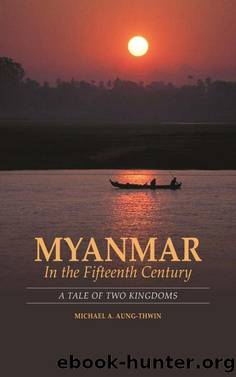Myanmar in the Fifteenth Century by Aung-Thwin Michael A.;

Author:Aung-Thwin, Michael A.;
Language: eng
Format: epub
Publisher: University of Hawaii Press
Published: 2017-09-15T00:00:00+00:00
Apart from such fine examples of Pali verse, Pali scholarship per se was also at an advanced stage at Pagan, with at least several dozen works written in the language that received high acclaim at the time. Most of the subject matter was religious, including treatises on Buddhist philosophy, the Vinaya (text on monastic rules), and the Abhidhamma (commentaries on Buddhist philosophy). One particular treatise that stood out, written approximately around 1154 AD, was the Saddaniti, a Pali grammar that was acclaimed even by scholars from Sri Lanka, considered the supreme center for Pali scholarship at the time. The work is still considered a valuable contribution to Pali studies in general.
How fine works in Pali translate into fine works in Old Burmese literature is, of course, debatable. And when it comes to secular, vernacular Burmese verse, Ava seems to have eclipsed Pagan. Some of the most important literary figures at Ava include Ariyavamsa, Shin Uttamagyaw, Shin Thilawuntha, Shin Rattathara, Saddhammakitti, Shin Aggathamadhi, and Lady Yaweshinhtwe, not to mention two poetesses, Mi Nyo and Mi Phyu (Miss Brown and Miss White). This subject has seen very little scholarship in English, particularly research that has been derived from the primary sources. It could easily be a book-length monograph in itself, so what little is described here should be taken only as a very preliminary summary of what still needs to be done. My synopsis here is gleaned from both the primary sources, mainly the Ava inscriptions, in which verse abounds, as well as from secondary sources written by scholars on the subject, particularly the works of Mabel Bode, Anna Allott, John Okell, Dr. Hla Pe, Pe Maung Tin, U Kyaw Dun, and U Saw Tun.6
Shin Ariyavamsa was from Pagan and lived at Ava during the reign of Narapati the Great. He had studied at Sagaing earlier, showing how, even during times of military chaos, there were oases of peace, quiet, and learning. His training resulted in the writing of a treatise called the Manisaramanjusa, a commentary on the Abhidhammatthavibhavani. He wrote and taught at Sagaing, but moved to Ava, as it had become the kingdomâs center of scholarship. According to Mabel Bode, one of his most important later works was the Manidipa, a treatise on the Atthasalini (a commentary) of Buddhaghosa, perhaps the most celebrated of all Buddhist monks in the Sinhalese tradition. Ariyavamsa also composed a grammatical treatise called the Gandhabharana and a study of the Jatakas called the Jatakavisodhana. He wrote mostly in Pali but also showed his talents in the vernacular, composing the first metaphysical work in Burmese, an atthayojana (interpretation) of a commentary, called the Anutika, on the Abhidhamma.
The next Buddhist scholar at Ava able to fill his shoes was Shin Thilawuntha. He and Shin Uttamagyaw were contemporaries, as monks who had entered the same monastery at Taungdwingyi, a provincial governorship under Ava (northwest of Naypyidaw, the present capital). The former wrote religious works in verse, such as of the Sumedhakatha (the story of the ascetic Sumedha, which
Download
This site does not store any files on its server. We only index and link to content provided by other sites. Please contact the content providers to delete copyright contents if any and email us, we'll remove relevant links or contents immediately.
| Africa | Americas |
| Arctic & Antarctica | Asia |
| Australia & Oceania | Europe |
| Middle East | Russia |
| United States | World |
| Ancient Civilizations | Military |
| Historical Study & Educational Resources |
The Story of China by Michael Wood(928)
Mr. Selden's Map of China by Timothy Brook(775)
Philippines--Culture Smart! by Culture Smart!(669)
Heroic Hindu Resistance To Muslim Invaders (636 AD to 1206 AD) by Sita Ram Goel(655)
Akbar: The Great Mughal by Ira Mukhoty(651)
The Meaning of India by Raja Rao(631)
Vedic Physics: Scientific Origin of Hinduism by Raja Ram Mohan Roy(624)
Food of India by unknow(618)
Banaras by Diana L. Eck(614)
India--Culture Smart! by Becky Stephen(602)
First Platoon by Annie Jacobsen(601)
China Unbound by Joanna Chiu(601)
Mao's Great Famine: The History of China's Most Devastating Catastrophe, 1958-1962 by Frank Dikötter(594)
North of South by Shiva Naipaul(590)
Insurgency and Counterinsurgency by Jeremy Black(564)
How to Be a Modern Samurai by Antony Cummins(563)
The Genius of China: 3,000 Years of Science, Discovery, and Invention by Robert Temple(562)
A History of Japan by R.H.P. Mason & J.G. Caiger(561)
The Digital Silk Road by Jonathan E. Hillman(550)
